Assessing the Impact of Man–Made Ponds on Soil Erosion and Sediment Transport in Limnological Basins
Abstract
1. Introduction
2. Materials and Methods
2.1. Study Area
2.2. The SWAT Model: Basins and Impoundments
2.3. The CORINE Erosion Model
2.4. Input Data and Adaptation to the SWAT and CORINE Models
2.4.1. DEM: Topographic Effect and Use in Both Models
2.4.2. Pedology: Adaptation to the Different Requirements of the Models Used
2.4.3. Weather Data: Forcing on-Field Weather Data to a Meteorological Model
2.4.4. Land Use and Land Cover: A Particularly Rich Natural Limnological Setting
3. Results
3.1. CORINE Erosion Model Outputs for the Claise Basin
3.1.1. Soil Erodibility
3.1.2. Erosivity in a Degraded Oceanic Climate Setting
3.1.3. Topography (Slope): A Reduced Effect in a Flat Setting
3.1.4. Potential Soil Erosion Map
3.1.5. Vegetation Cover: The Presence/Absence Effect of Ponds
3.1.6. Actual Soil Erosion Maps Under Current and Alternative Scenarios
3.2. Sediment Transport in a Limnologically Rich Setting
4. Conclusions
Author Contributions
Funding
Acknowledgments
Conflicts of Interest
References
- Gyamfi, C.; Ndambuki, J.M.; Salim, R.W. Simulation of sediment yield in a semi–arid river basin under changing land use: An integrated approach of hydrologic modelling and principal component analysis. Sustainability 2016, 8, 1133. [Google Scholar] [CrossRef]
- Dwarakish, G.S.; Ganasri, B.P. Impact of land use change on hydrological systems: A review of current modeling approaches. Cogent Geosci. 2015, 1, 1115691. [Google Scholar] [CrossRef]
- van Rijn, L.C. Principles of Sediment Transport in Rivers, Estuaries and Coastal Seas; Aqua Publications: Amsterdam, The Netherlands, 1993; p. 690. [Google Scholar]
- Esa, E.; Assen, M.; Legass, A. Implications of land use/cover dynamics on soil erosion potential of agricultural watershed, northwestern highlands of Ethiopia. Env. Syst. Res. 2018, 7, 21. [Google Scholar] [CrossRef]
- Aksoy, H.; Mahe, G.; Meddi, M. Modeling and Practice of Erosion and Sediment Transport under Change. Water 2019, 11, 1665. [Google Scholar] [CrossRef]
- Zhang, S.; Li, Z.; Lin, X.; Zhang, C. Assessment of Climate Change and Associated Vegetation Cover Change on Watershed–Scale Runoff and Sediment Yield. Water 2019, 11, 1373. [Google Scholar] [CrossRef]
- Bussi, G.; Dadson, S.J.; Prudhomme, C.; Whitehead, P.G. Modelling the future impacts of climate and land–use change on suspended sediment transport in the River Thames (UK). J. Hydrol. 2016, 542, 357–372. [Google Scholar] [CrossRef]
- Ffolliott, P.F.; Brooks, K.C.; Neary, D.G.; Tapia, P.R.; Chevesich, P.G. Soil Erosion and Sediment Production on Watershed Landscapes: Processes and Control, UNESCO Special Technical Publication No. 32; USDA: Washington, DC, USA, 2013; p. 73.
- Aga, A.O.; Chane, B.; Melesse, A.M. Soil erosion modelling and risk assessment in data Scarce Rift Valley Lake Regions, Ethiopia. Water 2018, 10, 1684. [Google Scholar] [CrossRef]
- Laflen, J.M.; Lane, L.J.; Foster, G.R. WEPP: A new generation of erosion prediction technology. J. Soil Water Conserv. 1991, 46, 34–38. [Google Scholar]
- Flanagan, D.C.; Gilley, J.E.; Franti, T.G. Water Erosion Prediction Project (WEPP) Development History, Model Capabilities and Future Enhancements. Am. Soc. Agric. Biol. Eng. 2007, 50, 1603–1612. [Google Scholar] [CrossRef]
- Wischmeier, W.H.; Smith, D.D. Predicting Rainfall Erosion Losses from Cropland East of the Rocky Mountains–Guide for Selection of Practices for Soil and Water Conservation, Agriculture Handbook No. 282; USDA: Washington, DC, USA, 1965.
- Williams, J.R. Sediment–Yield Prediction with Universal Soil Loss Equation Using Runoff Energy Factor. Present and Prospective Technology for Predicting Sediment Yields and Sources. In Proceedings of the Sediment Yield Workshop, Oxford, MS, USA, 17–18 January 1975; pp. 244–252. [Google Scholar]
- Renard, K.G.; Foster, G.R.; Weesies, G.A.; Mc Cool, D.K.; Yoder, D.C. Predicting Soil Erosion by Water: A Guide to Conservation Planning with the Revised Universal Soil Loss Equation (RUSLE); US Government Printing Office: Washington, DC, USA, 1997; Volume 703.
- Renard, K.G.; Yoder, D.C.; Lightle, D.T.; Dabney, S.M. . Universal Soil Loss Equation and Revised Universal Soil Loss Equation. In Handbook of Erosion Modelling; Morgan, R.P.C., Nearing, M., Eds.; Blackwell Publishing: Hoboken, NJ, USA, 2011; pp. 137–166. [Google Scholar]
- Arnold, J.G.; Srinivasan, R.; Muttiah, R.S.; Williams, J.R. Large area hydrologic modeling and assessment part I: Model development. J. Am. Water. Resour. Assoc. 1998, 34, 73–89. [Google Scholar] [CrossRef]
- Samaras, A.G.; Koutitas, C.G. Modeling the impact of climate change on sediment transport and morphology in coupled watershed–coast systems: A case study using an integrated approach. Int. J. Sediment. Res. 2015, 29, 304–315. [Google Scholar] [CrossRef]
- Kaffas, K.; Righetti, M.; Avesani, D.; Spiliotis, M.; Hrissanthou, V. Coupling CFSv2 with ArcSWAT for seasonal hydrological forecasting in a Mediterranean basin. In Proceedings of the 11th World Congress on Water Resources and Environment (EWRA 2019), Madrid, Spain, 25–29 June 2019; pp. 459–460. [Google Scholar]
- Napoli, M.; Massetti, L.; Orlandini, S. Hydrological response to land use and climate changes in a rural hilly basin in Italy. Catena 2017, 157, 1–11. [Google Scholar] [CrossRef]
- Alemaw, D.; Ayana, E.K.; Legesse, E.S.; Moges, M.M.; Tilahun, S.A.; Moges, M.A. Estimating reservoir sedimentation using bathymetric differencing and hydrologic modeling in data scarce Koga watershed, Upper Blue Nile, Ethiopia. J. Agric. Environ. Int. Dev. 2016, 110, 413–427. [Google Scholar] [CrossRef]
- Dhami, B.S.; Pandey, A. Comparative Review of Recently Developed Hydrologic Models. J. Indian Water Resour. Soc. 2013, 33, 34–42. [Google Scholar]
- Abbaspour, K.C.; Vaghefi, S.A.; Srinivasan, R. A guideline for successful calibration and uncertainty analysis for soil and water assessment: A review of papers from the 2016 international SWAT conference. Water 2017, 10, 6. [Google Scholar] [CrossRef]
- Biggs, J.; von Fumetti, S.; Kelly–Quinn, M. The importance of small waterbodies for biodiversity and ecosystem services: Implications for policy makers. Hydrobiologia 2016, 793, 3–39. [Google Scholar] [CrossRef]
- Mujere, N.; Eslamian, S. Climate Change Impacts on Hydrology and Water Resources. In Handbook of Engineering Hydrology Modeling, Climate Change and Variability; Eslamian, S., Ed.; CRC–Press: Boca Raton, FL, USA, 2014; pp. 114–125. [Google Scholar]
- Downing, J.A.; Prairie, Y.T.; Cole, J.J.; Duarte, C.M.; Tranvik, L.J.; Striegl, R.G.; McDowell, W.H.; Kortelainen, P.; Caraco, N.F.; Melack, J.M.; et al. The global abundance and size distribution of lakes, ponds, and impoundments. Limnol. Ocean. 2006, 51, 2388–2397. [Google Scholar] [CrossRef]
- Miracle, M.R.; Oertli, B.; Céréghino, R.; Hull, A. Preface: Conservation of European ponds–current knowledge and future needs. Limnetica 2010, 29, 1–8. [Google Scholar]
- Céreghino, R.; Biggs, J.; Oertli, B.; Declerck, S. The Ecology of European Ponds: Defining the Characteristics of a Neglected Freshwater Habitat, Hydrobiologia; Springer: Berlin/Heidelberg, Germany, 2008; Volume 597, pp. 1–6. [Google Scholar] [CrossRef]
- Williams, P.; Whitfield, M.; Biggs, J. How Can We Make New Ponds Biodiverse? A Case Study Monitored Over 7 Years, Hydrobiologia; Springer: Berlin/Heidelberg, Germany, 2008; Volume 597, pp. 137–148. [Google Scholar] [CrossRef]
- Céréghino, R.; Boix, D.; Cauchie, H.M.; Martens, K.; Oertli, B. The Ecological Role of Ponds In a Changing World, Hydrobiologia; Springer: Berlin/Heidelberg, Germany, 2014; Volume 723, pp. 1–6. [Google Scholar] [CrossRef]
- Sharpley, A.N.; Bergström, L.; Aronsson, H.; Bechmann, M.; Bolster, C.H.; Börling, K.; Djodjic, F.; Jarvie, H.P.; Schoumans, O.F.; Stamm, C.; et al. Future agriculture with minimized phosphorus losses to waters: Research needs and direction. Ambio 2015, 44, 163–179. [Google Scholar] [CrossRef]
- Oertli, B.; Frossard, P.A. Mares et Etangs: Ecologie, Conservation, Gestion, Valorisation, 1st ed.; Presses Polytechniques et Universitaires Romandes: Lausanne, Switzerland, 2013; p. 512. [Google Scholar]
- Hill, M.J.; Hassall, C.; Oertli, B.; Fahrig, L.; Robson, B.J.; Biggs, J.; Samways, M.J.; Usio, N.; Takamura, N.; Krishnaswamy, J.; et al. New policy directions for global pond conservation. Conserv. Lett. 2018, 11, 8. [Google Scholar] [CrossRef]
- Indermuehle, N.; Oertli, B.; Biggs, J.; Céréghino, R.; Grillas, P.; Hull, A.; Nicolet, P.; Scher, O. Pond conservation in Europe: The European Pond Conservation Network (EPCN). Int. Vereinigung Theor. Angew. Limnol. Verh. 2008, 30, 446–448. [Google Scholar] [CrossRef]
- Xiao, S.; Yang, H.; Liu, D.; Zhang, C.; Lei, D.; Wang, Y.; Peng, F.; Li, Y.; Wang, C.; Li, X.; et al. Gas transfer velocities of methane and carbon dioxide in a subtropical shallow pond. Tellus B Chem. Phys. Meteorol. 2014, 66, 23795. [Google Scholar] [CrossRef]
- Mujere, N.; Eslamian, S. Impact of Urbanization on Runoff Regime. In Handbook of Engineering Hydrology Modeling, Climate Change and Variability; Eslamian, S., Ed.; CRC–Press: Boca Raton, FL, USA, 2014; pp. 114–125. [Google Scholar]
- Nedjai, R.; Azaroual, A.; Chlif, K.; Bensaid, A.; Al Sayah, M.; Ysbaa, L. Impact of Ponds on Local Climate: A Remote Sensing and GIS Contribution Application to the Ponds of Brenne (France). J. Earth. Sci. Clim. Chang. 2018, 9, 10. [Google Scholar]
- Bennarrous, R. La Grande Brenne aux Périodes Préindustrielles (Indre) Contribution à L’histoire des Paysages, des Etangs et des Relations Sociétés/Milieux Dans une Zone Humide Continentale. Approches Historique, Archéologique et Paléo–Environnementale; Université de Paris I–Panthéon Sorbonne: Paris, France, 2009. [Google Scholar]
- Jalowska, A.M.; Yuan, Y. Evaluation of SWAT Impoundment Modeling Methods in Water and Sediment Simulations. J. Am. Water. Resour. Assoc. 2019, 55, 209–227. [Google Scholar] [CrossRef]
- Clifford, C.C.; Heffernan, J.B. Artificial Aquatic Ecosystems. Water 2018, 10, 1096. [Google Scholar] [CrossRef]
- Ebel, J.D.; Lowe, W.H. Constructed Ponds and Small Stream Habitats: Hypothesized Interactions and Methods to Minimize Impacts. J. Water. Resour. Prot. 2013, 5, 723–731. [Google Scholar] [CrossRef]
- Ismail, T.; Othman, M.A.; Fadzil, A.B.; Zainuddin, Z.M. Deposition of Sediments in Detention Pond. Malaysian. J. Civ. Eng. 2010, 22, 95–118. [Google Scholar]
- Declerck, S.; De Bie, T.; Ercken, D.; Hampel, H.; Schrijvers, S.; Van Wichelen, J.; Gillard, V.; Mandiki, R.; Losson, B.; Bauwens, D.; et al. Ecological characteristics of small farmland ponds: Associations with land use practices at multiple spatial scales. Biol. Conserv. 2006, 131, 523–532. [Google Scholar] [CrossRef]
- Fairchild, G.W.; Velinsky, D.J. Effects of Small Ponds on Stream Water Chemistry. Lake. Reserv. Manag. 2006, 22, 321–330. [Google Scholar] [CrossRef]
- Commission Européenne. La Directive–Cadre Européenne sur l’Eau; Commission Européenne: Brussels, Belgium, 2000. [Google Scholar]
- Biggs, J.; Williams, P.; Whitfield, P.; Nicolet, P.; Weatherby, A. 15 years of pond assessment in Britain: Results and lessons learned from the work of Pond Conservation. Aquat. Conserv. Mar. Freshw. Ecosyst. 2005, 15, 693–714. [Google Scholar] [CrossRef]
- Jeffries, M. Local–Scale Turnover of Pond Insects: Intrapond Habitat Quality and Inter–Pond Geometry are Both Important, Hydrobiologia; Springer: Berlin/Heidelberg, Germany, 2005; Volume 543, pp. 207–220. [Google Scholar]
- Neitsch, S.L.; Arnold, J.G.; Kiniry, J.R.; Williams, J.R. Soil & Water Assessment Tool Theoretical Documentation Version 2009. Texas Water Resources Institute Technical Report No.406: College Station, TX, USA, 2011. [Google Scholar]
- Almendinger, J.E.; Murphy, M.S.; Ulrich, J.S. Use of the Soil and Water Assessment Tool to Scale Sediment Delivery from Field to Watershed in an Agricultural Landscape with Topographic Depressions. J. Environ. Qual. 2014, 43, 9–17. [Google Scholar] [CrossRef] [PubMed]
- Guichané, R. L’aménagement hydraulique de la Claise tourangelle et de ses affluents du Moyen–Âge à nos jours/Mills on the Claise and its tributaries in Indre–et–Loire from the Middle Ages to modern times. Rev. Archeol. Centre France 1993, 32, 109–152. [Google Scholar] [CrossRef]
- SANDRE. Fiche Cours D’eau la Claise (L6––0200); SANDRE: Paris, France, 2012. [Google Scholar]
- Joly, D.; Brossard, T.; Cardot, H.; Cavailhes, J.; Hilal, M.; Wavresky, P. Les types de climats en France, une construction spatiale–Types of climates on continental France, a spatial construction. Cybergéo Eur. J. Geogr. 2010, 501, 1–23. [Google Scholar]
- Fischer, G.; Nachtergaele, F.; Prieler, S.; van Velthuizen, H.T.; Verelst, L.; Wiberg, D. Global Agro–Ecological Zones Assessment for Agriculture (GAEZ 2008); IIASA: Laxenburg, Austria; FAO: Rome, Italy, 2008. [Google Scholar]
- Dauphin, P.; Mansons, J.; Pellé, B.; Airault, V.; Trotignon, J.; Boyer, P.; Chatton, T.; Issa, N. Document D’objectifs des Sites Natura 2000 FR2410003 “Brenne” et FR2400534 “Grande Brenne.”. Available online: http://natura2000.mnhn.fr/uploads/doc/PRODBIOTOP/1847_DOCOB_BRENNE.pdf (accessed on 29 November 2019).
- Bouscasse, H.; Defrance, P.; Amand, B.; Grandmougi, B.; Strosser, P.; Beley, Y. Amélioration des connaissances sur les fonctions et usages des zones humides: Évaluation économique sur des sites tests le cas des étangs de la Grande Brenne. Available online: http://oaidoc.eau-loire-bretagne.fr/exl-doc/DOC00021327_s3.pdf (accessed on 29 November 2019).
- Arnold, J.G.; Kiniry, J.R.; Srinivasan, R.; Williams, J.R.; Haney, E.B.; Neitsch, S.L. Soil & Water Assessment Tool Input/Output Documentation Version 2012; Texas Water Resources Institute: College Station, TX, USA, 2012; p. 541. [Google Scholar]
- Kaffas, K.; Hrissanthou, V.; Sevastas, S. Modeling hydromorphological processes in a mountainous basin using a composite mathematical model and ArcSWAT. Catena 2018, 162, 108–129. [Google Scholar] [CrossRef]
- Gassman, P.W.; Reyes, M.R.; Green, C.H.; Arnold, J.G. The Soil and Water Assessment Tool: Historical Development, Applications, and Future Research Directions. Am. Soc. Agric. Biol. Eng. 2007, 50, 1211–1250. [Google Scholar] [CrossRef]
- Epelde, A.M.; Cerro, I.; Sánchez–Pérez, J.M.; Sauvage, S.; Srinivasan, R.; Antigüedad, I. Application of the SWAT model to assess the impact of changes in agricultural management practices on water quality. Hydrol. Sci. J. 2014, 60, 825–843. [Google Scholar] [CrossRef]
- Srinivasan, R.; Zhang, X.; Arnold, J. SWAT ungauged: Hydrological budget and crop yield predictions in the Upper Mississippi river basin. Trans. ASABE 2010, 53, 1533–1546. [Google Scholar] [CrossRef]
- Neitsch, S.L.; Arnold, J.G.; Kiniry, J.R.; Rinivasan, R.S.; Williams, J.R. Soil and Water Assessment Tool User’s Manual–Version 2000; Texas Water Resources Institute: College Station, TX, USA, 2002. [Google Scholar]
- Kaffas, K.; Hrissanthou, V. Annual sediment yield prediction by means of three soil erosion models at the basin scale. In Proceedings of the 10th World Congress of EWRA “Panta Rhei”, Athens, Greece, 5–9 July 2017; pp. 1346–1352. [Google Scholar]
- CORINE. CORINE Soil Erosion Risk and Important Land Resources-in the Southern Regions of the European Community; European Community-European Environment Agency: Copenhagen, Denmark, 1992; p. 541. [Google Scholar]
- Fournier, F. Climat et Erosion: La Relation Entre l’Erosion du sol par l’Eau et Les Precipitations Atmospheriques; Presses Universitaires De France: Paris, France, 1960; p. 201. [Google Scholar]
- Gaussen, H. Bioclimatic Map of Mediterranean Zone; UNESCO and FAO: Paris, France, 1963. [Google Scholar]
- Arnold, J.G.; Moriasi, D.N.; Gassman, P.W.; Abbaspour, K.C.; White, M.J.; Srinivasan, R.; Santhi, C.; Harmel, R.D.; van Griensven, A.; van Liew, M.W.; et al. SWAT: Model use, Calibration, and Validation. Am. Soc. Agric. Biol. Eng. 2012, 55, 1491–1508. [Google Scholar]
- Hallouz, F.; Meddi, M.; Mahé, G.; Alirahmani, S.; Keddar, A. Modeling of discharge and sediment transport through the SWAT model in the basin of Harraza (Northwest of Algeria). Water. Sci. 2018, 32, 79–88. [Google Scholar] [CrossRef]
- Buakhao, W.; Kangrang, A. DEM Resolution Impact on the Estimation of the Physical Characteristics of Watersheds by Using SWAT. Adv. Civ. Eng. 2016, 2016, 9. [Google Scholar] [CrossRef]
- Polanco, E.I.; Fleifle, A.; Ludwig, R.; Disse, M. Improving SWAT model performance in the upper Blue Nile Basin using meteorological data integration and subcatchment discretization. Hydrol. Earth. Syst Sci. 2017, 21, 4907–4926. [Google Scholar] [CrossRef]
- USDA. USDA Soil Conservation Service. National Engineering Handbook, Section 4: Hydrology; NEH Notice 4–102; USDA: Washington, DC, USA, 1972.
- Saxton, K.; Rawls, W.J. Soil Water Characteristic Estimates by Texture and Organic Matter for Hydrologic Solutions. Soil. Sci. Soc. Am. J. 2006, 70, 1569–1578. [Google Scholar] [CrossRef]
- Al Sayah, M.J.; Abdallah, C.; Khouri, M.; Nedjai, R.; Darwich, T. Application of the LDN concept for quantification of the impact of land use and land cover changes on Mediterranean watersheds–Al Awali basin–Lebanon as a case study. Catena 2019, 176, 264–278. [Google Scholar] [CrossRef]
- Périé, C.; Ouimet, R. Organic carbon, organic matter and bulk density relationships in boreal forest soils. Can. J. Soil. Sci. 2008, 88, 315–325. [Google Scholar] [CrossRef]
- Post, D.F.; Fimbres, A.; Matthias, A.D.; Sano, E.E.; Accioly, L.; Batchily, A.K.; Ferreira, L.G. Predicting Soil Albedo from Soil Color and Spectral Reflectance Data. Soil. Sci. Soc. Am. J. 2000, 64, 1027–1034. [Google Scholar] [CrossRef]
- Durand, Y.; Brun, E.; Mérindol, L.; Guyomarc’h, G.; Lesaffre, B.; Martin, E. A meteorological estimation of relevant parameters for snow models. Ann. Glaciol. 1993, 18, 65–71. [Google Scholar] [CrossRef]
- Pearson, K. Notes on regression and inheritance in the case of two parents. Proc. R. Soc. Lond. 1985, 58, 240–242. [Google Scholar]
- SWAT. SWAT Weather Data and Tools [Internet]. Available online: https://swat.tamu.edu/software/ (accessed on 8 March 2019).
- Wang, X.; Yang, W.; Melesse, A.M. Using Hydrologic Equivalent Wetland Concept within SWAT to Estimate Streamflow in Watersheds with Numerous Wetlands. Trans. Am. Soc. Agric. Eng. 2008, 51, 55–72. [Google Scholar] [CrossRef]
- Ahmed, S.I.; Rudra, R.P.; Gharabaghi, B.; Mackenzie, K.; Dickinson, W.T. Within–Storm Rainfall Distribution Effect on Soil Erosion Rate. ISRN Soil. Sci. 2012, 2012, 1–7. [Google Scholar] [CrossRef]
- Akale, A.T.; Dagnew, D.C.; Belete, M.A.; Tilahun, S.A.; Mekruia, W.; Steenhuis, T.S. Impact of Soil Depth and Topography on the Effectiveness of Conservation Practices on Discharge and Soil Loss in the Ethiopian Highlands. Land 2017, 6, 78. [Google Scholar] [CrossRef]
- Gis Sol; INRA; SOeS. Aléa D’érosion des Sols en 2000; Institut national de la recherche agronomique: Orléans, France, 2000. [Google Scholar]
- Cohen, J. A coefficient of agreement for nominal scales. Educ. Psychol. Meas. 1960, 20, 37–46. [Google Scholar] [CrossRef]
- Verheijen, F.G.A.; Jones, R.J.A.; Rickson, R.J.; Smith, C.J. Tolerable versus actual soil erosion rates in Europe. Earth Sci. Rev. 2009, 94, 23–38. [Google Scholar] [CrossRef]
- Kondolf, G.M. Hungry water: Effects of dams and gravel mining on river channels. Environ. Manag. 1997, 21, 533–551. [Google Scholar] [CrossRef]
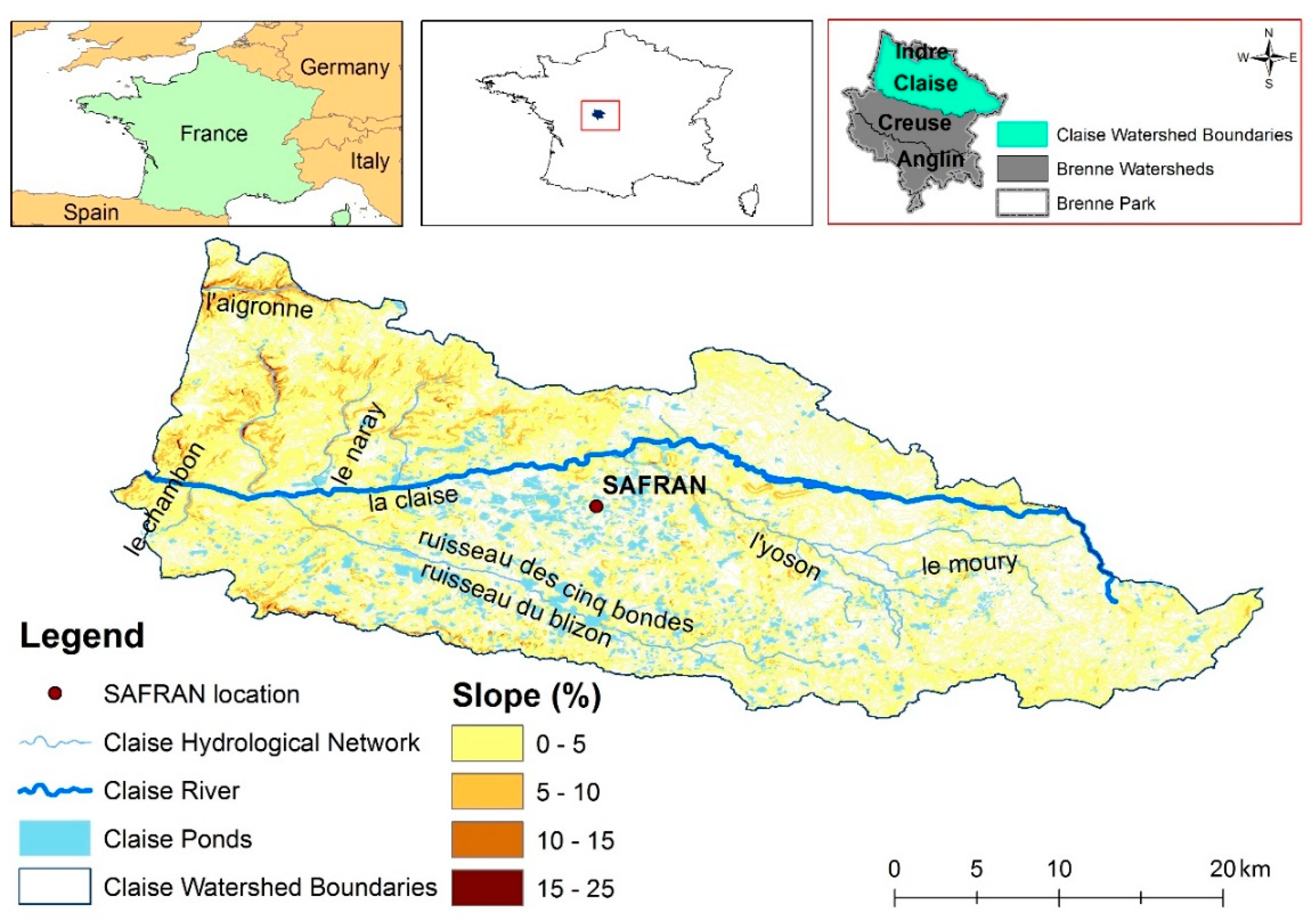
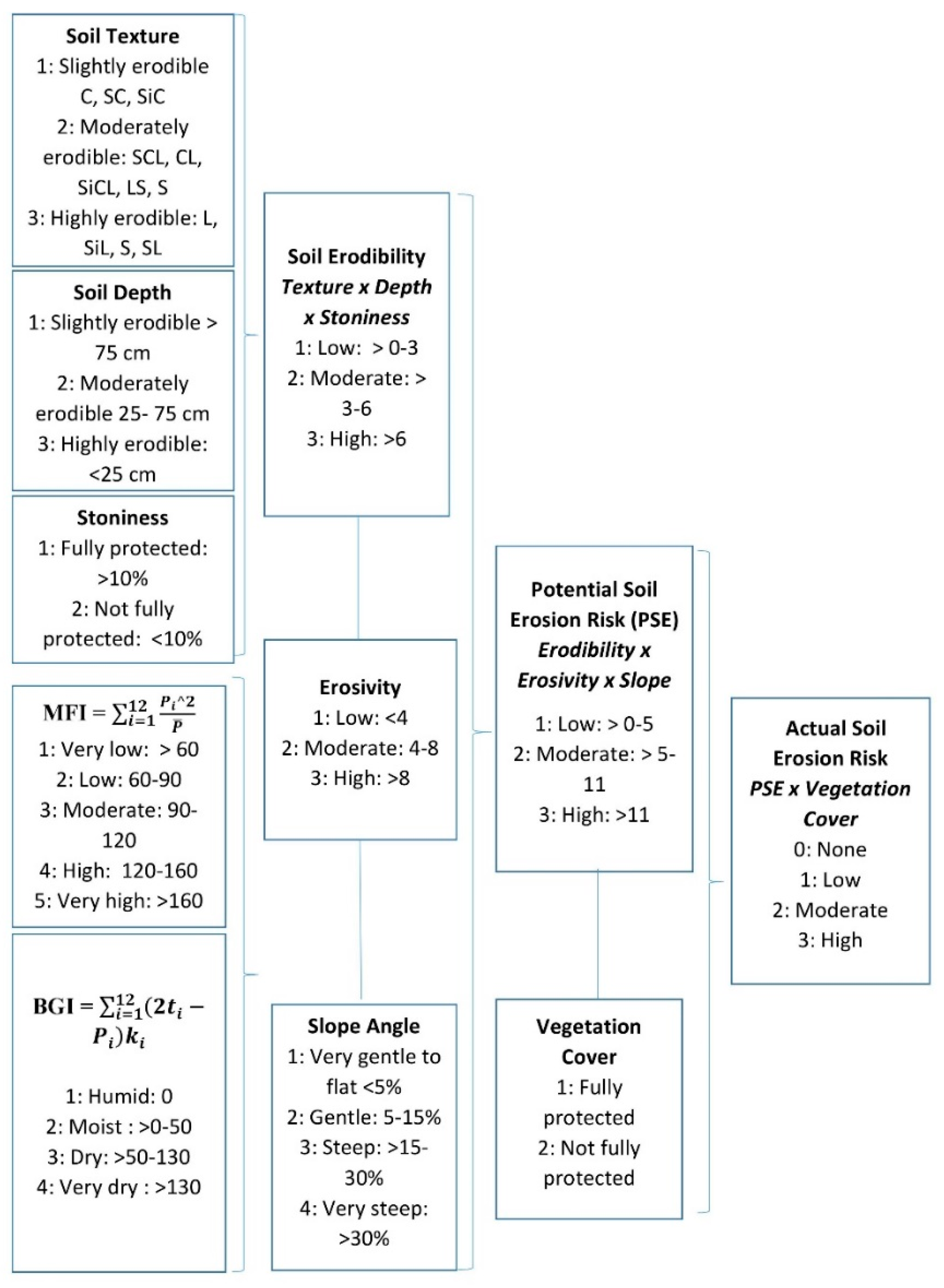
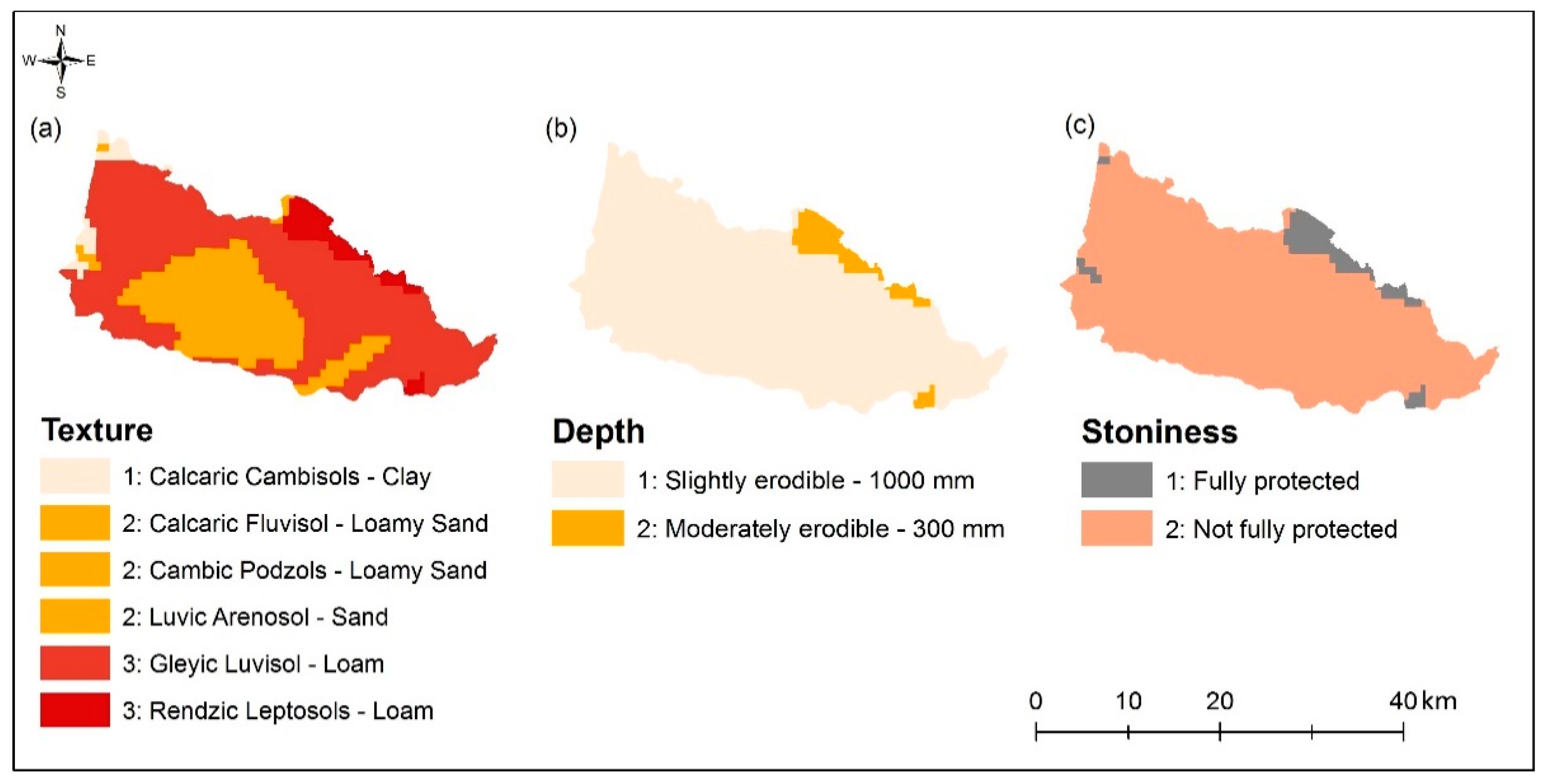
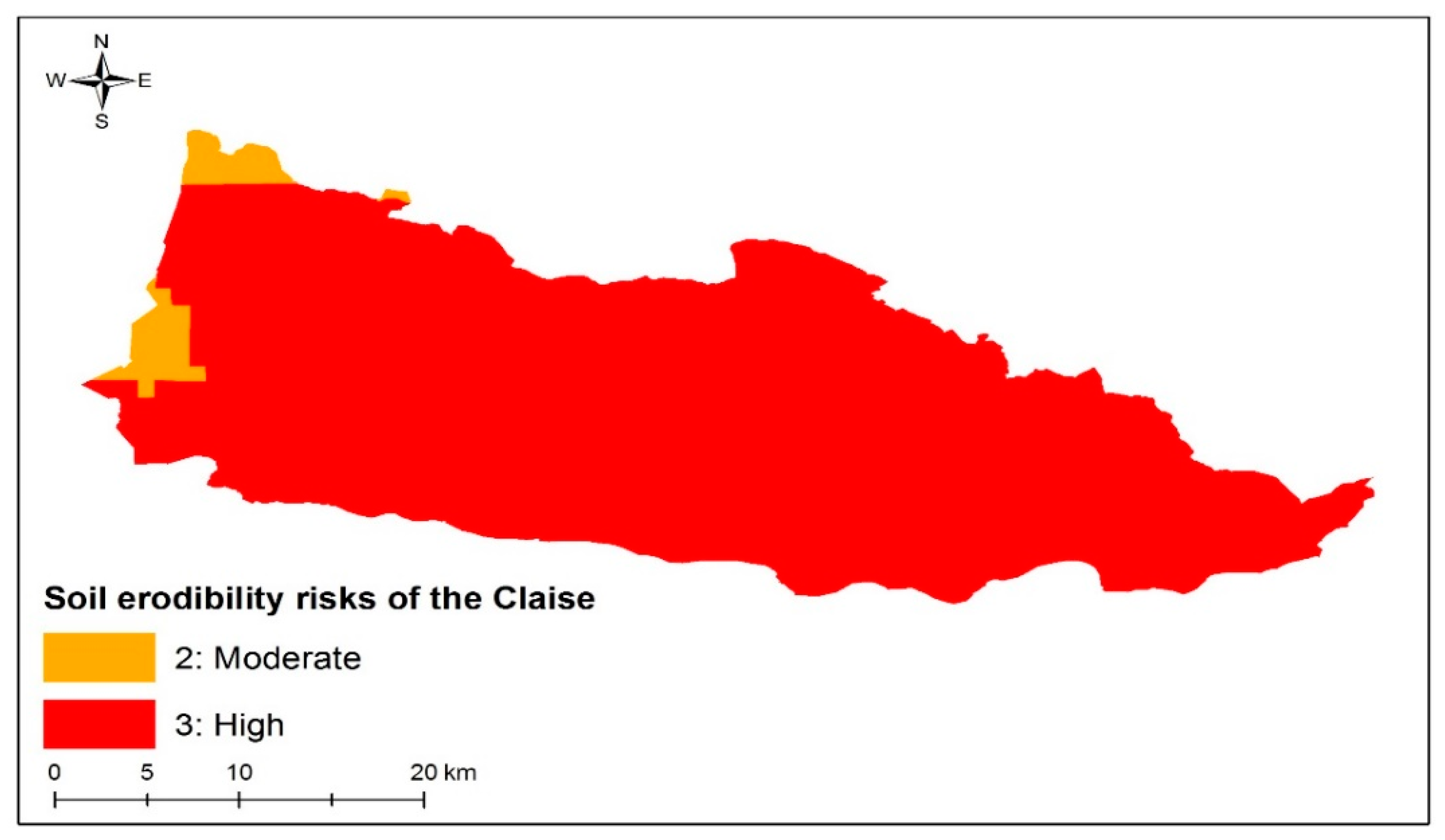
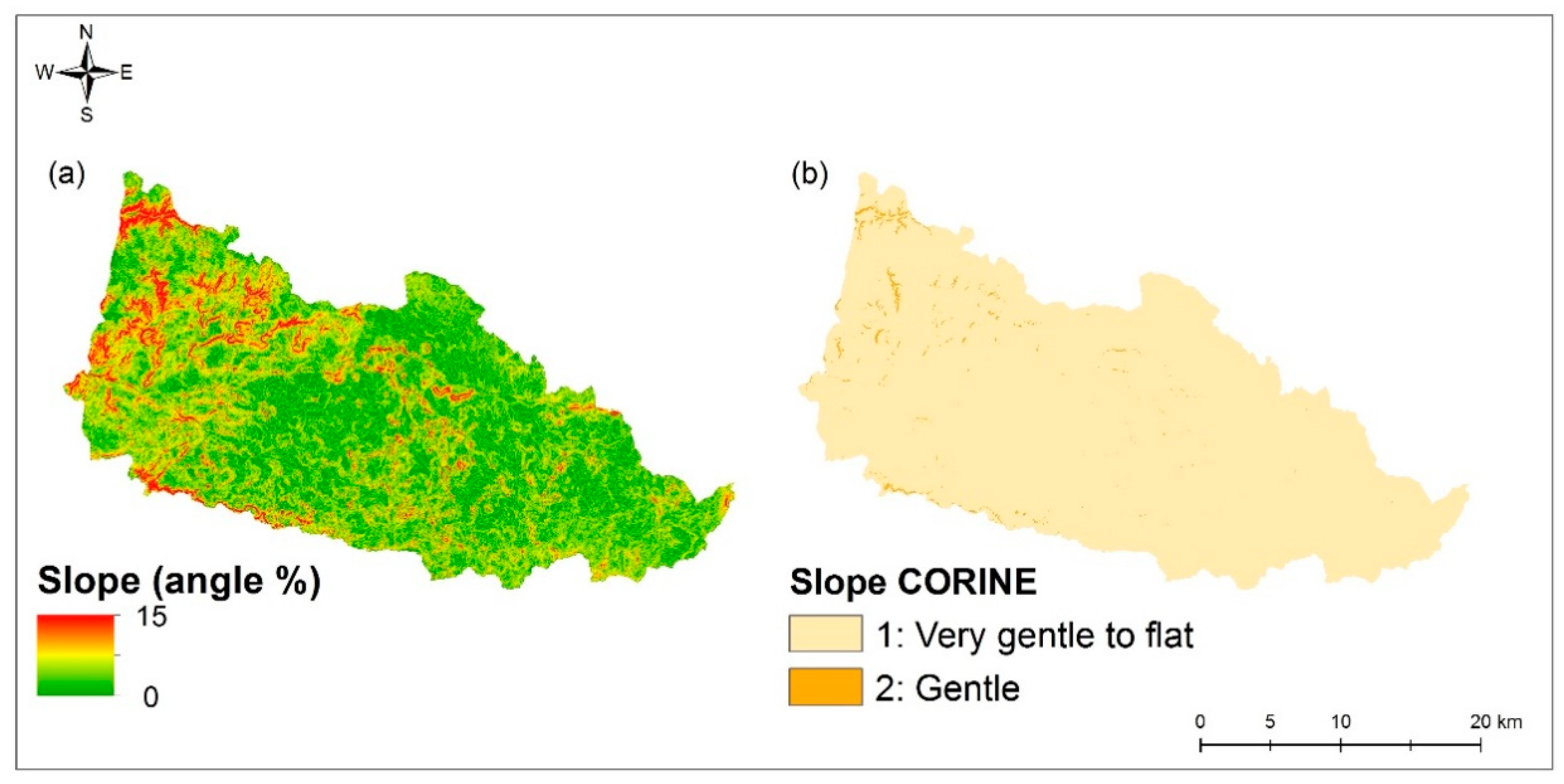
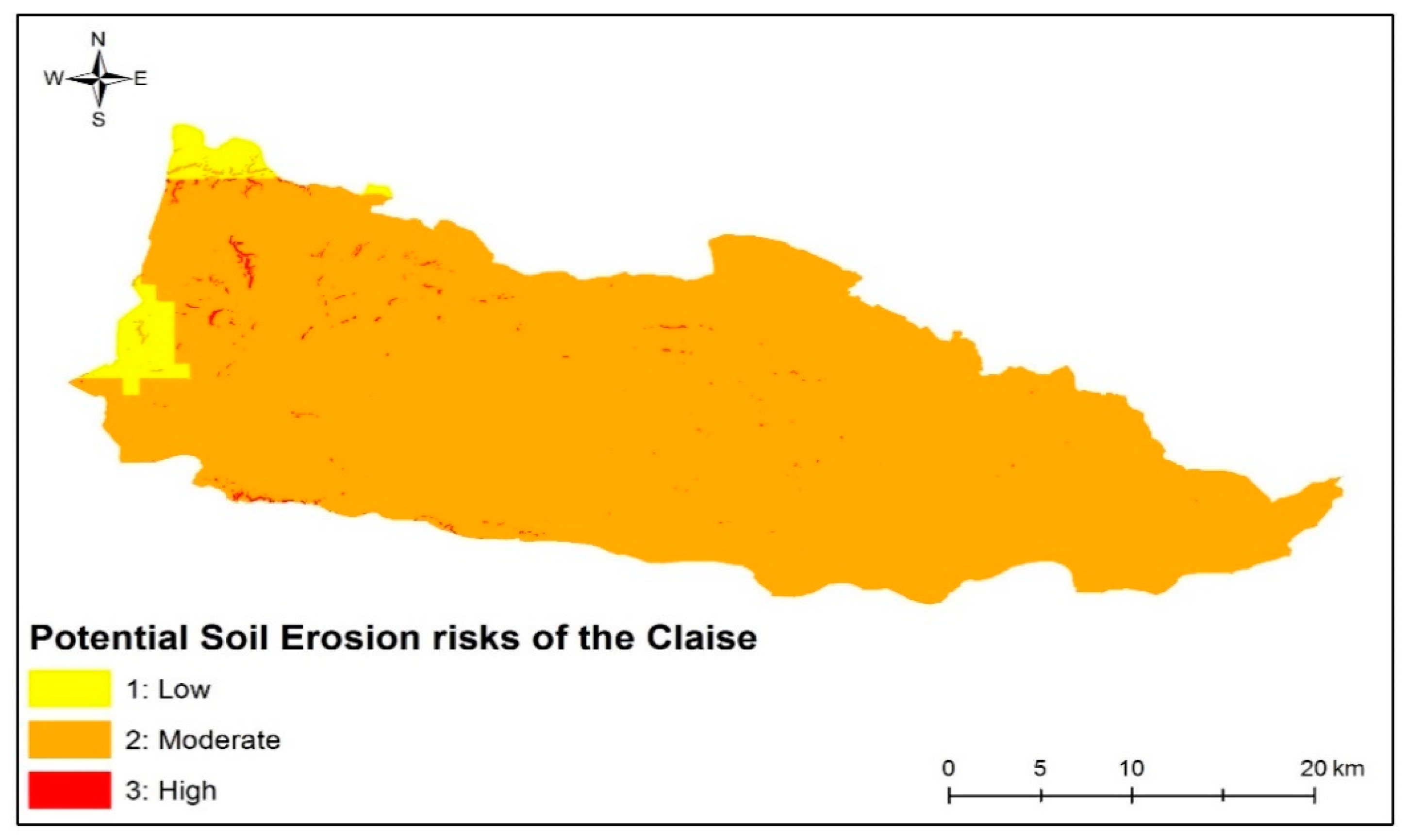
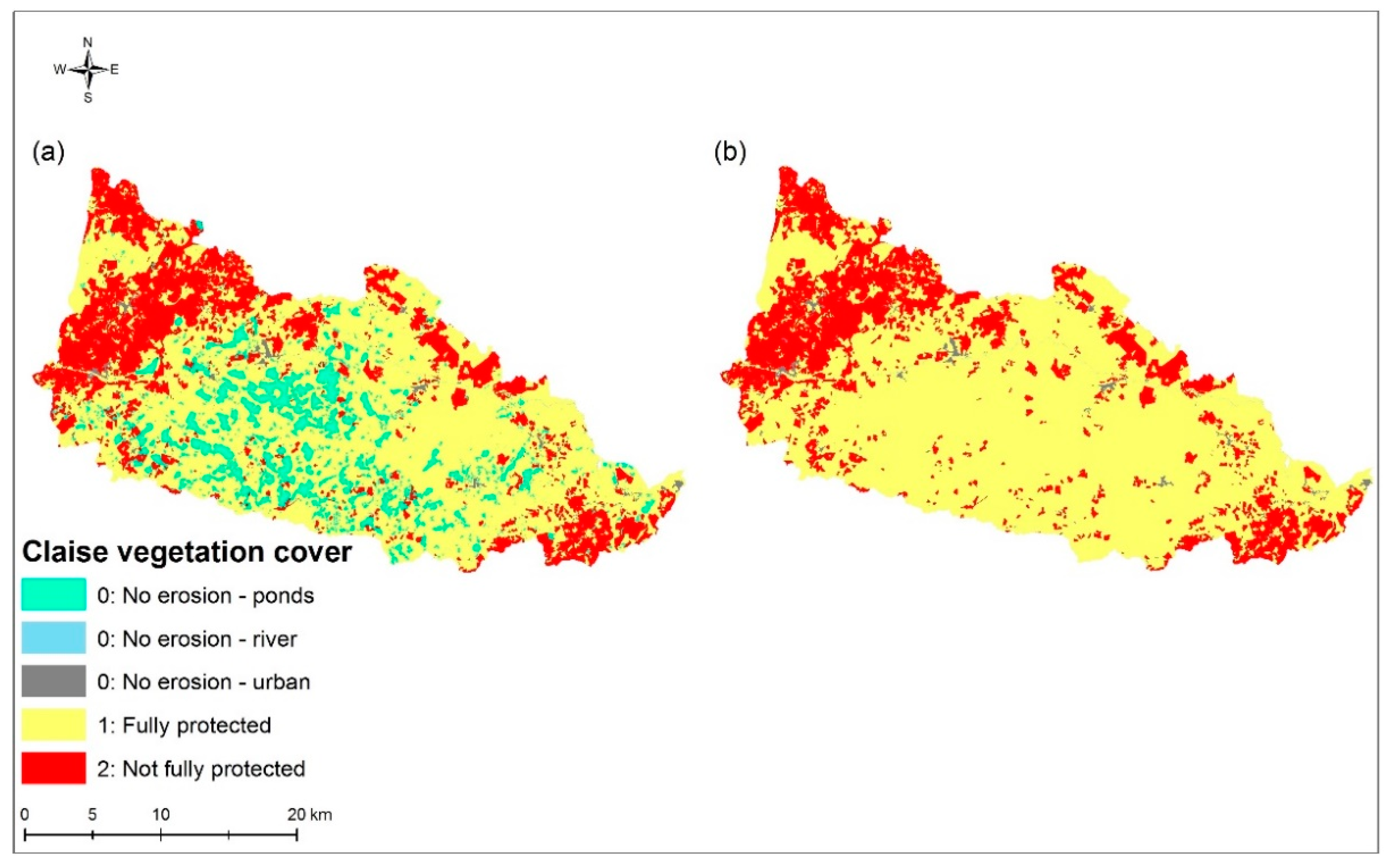
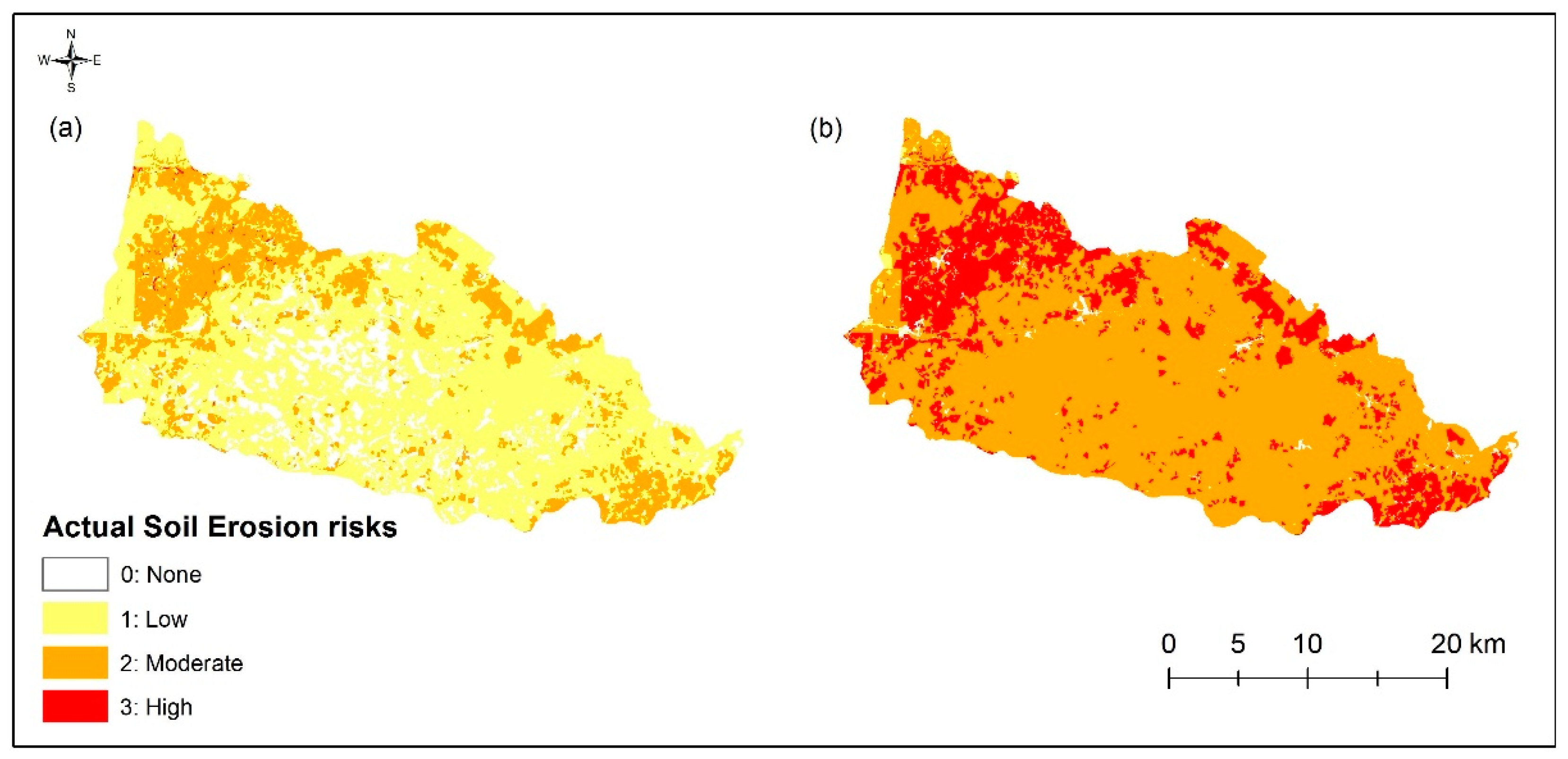
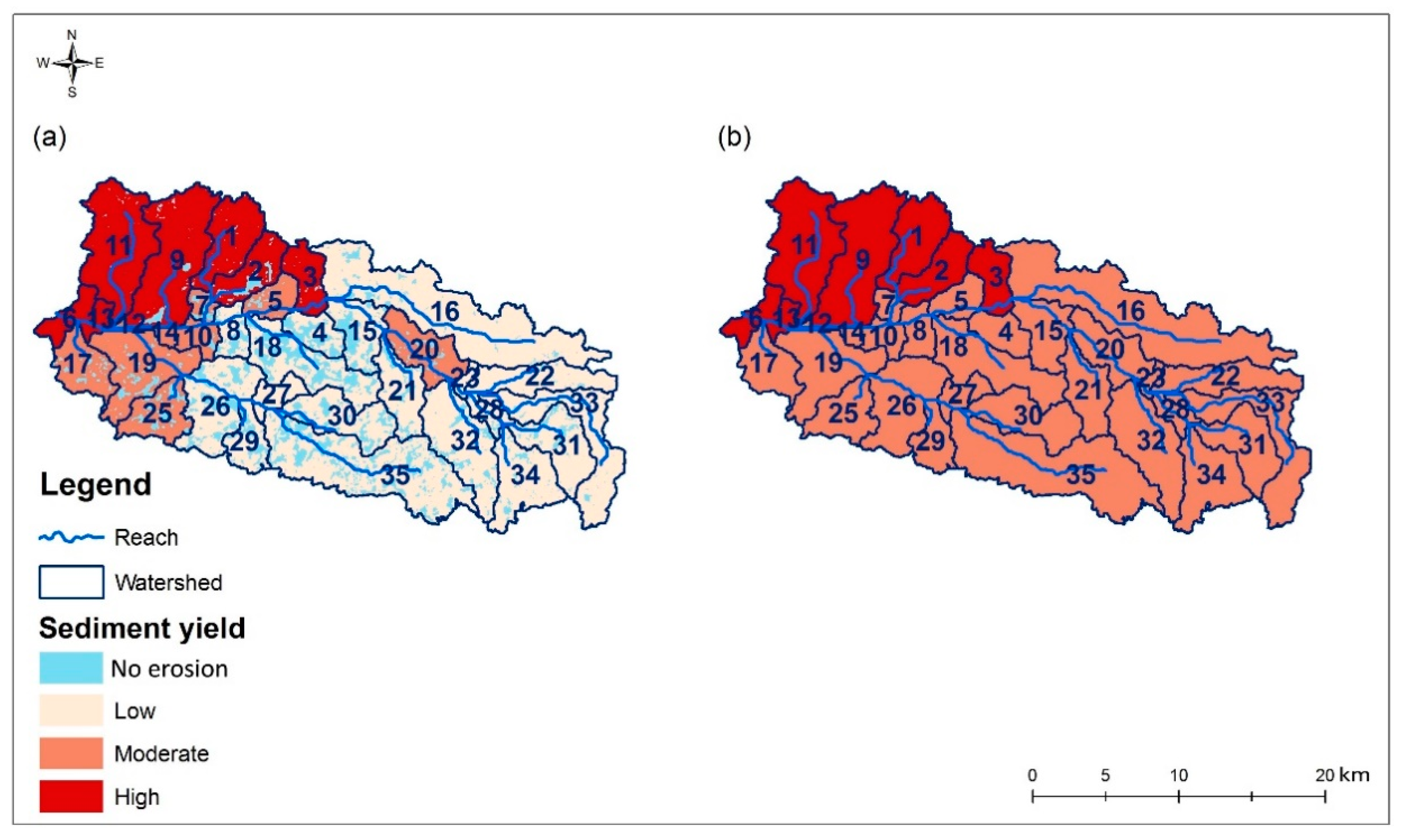
| Input Data | Source | Date † | Description |
|---|---|---|---|
| Topography—DEM | Institut Géographique National (IGN)—France | 2010 | 25 m resolution |
| Soil map | Harmonized World Soil Database (HWSD) [52] | 2008 | 30 arc-second raster database |
| Weather data | Weatherlink Pro 2 weather stations, source: R. Nedjai (Dynétangs) | 2016–2018 | Daily time step |
| Système d’Analyse Fournissant des Renseignements Adaptés à la Nivologie (SAFRAN) model (Durand et al., 1993) | 1970–2018 | ||
| Land Use/Land Cover map | Digitized from aerial photography and cross-checked against ancillary maps | 2018 | Ortho-rectified aerial photography-Resolution: 0.5 m verified against ancillary maps: CORINE 2012 land use/land cover maps |
| Weather Stations Parameters | SAFRAN Parameters | Parameter Label | Correlation, r |
|---|---|---|---|
| Temp Out | T_Q | Average temperature (°C) | 0.98 |
| Hi Temp | TSUP_H_Q | Maximal temperature (°C) | 0.98 |
| Low Temp | TINF_H_Q | Minimal temperature (°C) | 0.97 |
| Out Hum | HU_Q | Relative humidity (%) | 0.97 |
| Wind Speed | FF_Q | Wind speed (m/s) | 0.83 |
| Rain | PE_Q | Efficient rainfall (mm) | 0.64 |
| Solar Rad. | SSI_Q | Incoming solar radiation (J/cm2) | 0.98 |
| Land Occupation Class | Area (km2) | Percentage (%) | CORINE Vegetation Cover Index |
|---|---|---|---|
| Clear broad—leaved forest | 2.21 | 0.31 | 1 |
| Clear mixed forest | 0.90 | 0.13 | 1 |
| Coniferous forest | 26.94 | 3.81 | 1 |
| Dense broad—leaved forest | 163.58 | 23.11 | 1 |
| Dense mixed forest | 27.00 | 3.82 | 1 |
| Field crops in medium to large terraces | 19.14 | 2.70 | 2 |
| Fruit trees | 0.20 | 0.03 | 2 |
| Grassland | 207.04 | 29.26 | 1 |
| Inland marshes | 4.01 | 0.57 | 1 |
| Low density urban tissue | 3.24 | 0.46 | 2 |
| Medium density urban tissue | 1.76 | 0.25 | 2 |
| Mineral extraction site | 0.09 | 0.01 | 2 |
| Non–irrigated field crops | 151.17 | 21.36 | 2 |
| Pond | 79.47 | 11.23 | 0 |
| River | 0.55 | 0.08 | 0 |
| Scrubland | 2.80 | 0.40 | 1 |
| Scrubland with some bigger dispersed trees | 15.36 | 2.17 | 1 |
| Urban expansion site | 0.01 | 0 | 2 |
| Urban sprawl on clear wooded lands | 0.01 | 0 | 2 |
| Urban sprawl on field crops | 1.01 | 0.14 | 2 |
| Urban sprawl on grassland | 1.20 | 0.17 | 2 |
| Parameter | CORINE Class | Area (km2) | Percentage (%) |
|---|---|---|---|
| Soil Texture | 1: Slightly erodible (clay) | 17.53 | 2.48 |
| 2: Moderately erodible (loamy sand and sand) | 205.88 | 29.12 (28.77 and 0.35) | |
| 3: Highly erodible (loam) | 483.59 | 68.4 | |
| Total | 707 | 100 | |
| Soil Depth | 1: Slightly erodible (>1000 mm) | 668.82 | 94.6 |
| 2: Moderately erodible (250–750 mm) | 38.18 | 5.4 | |
| Total | 707 | 100 | |
| Stoniness | 1: Fully protected (>10%) | 43.26 | 6.12 |
| 2: Not fully protected (<10%) | 663.73 | 93.88 | |
| Total | 707 | 100 |
| Month | January | February | March | April | May | June | July | August | September | October | November | December |
|---|---|---|---|---|---|---|---|---|---|---|---|---|
| Average temp. (°C) | 4.7 | 5.2 | 7.8 | 10.4 | 14.3 | 17.9 | 20.1 | 19.7 | 16.1 | 11.8 | 7.7 | 4.8 |
| Precipitation (mm) | 416 | 677 | 1106 | 1526 | 1782 | 2045 | 2108 | 1826 | 1356 | 818 | 482 | 361 |
| Classes | Low | Moderate | High | Validation Points |
|---|---|---|---|---|
| Low | 76 | 10 | 0 | 86 |
| Moderate | 15 | 14 | 8 | 37 |
| High | 0 | 0 | 11 | 11 |
| Total | 91 | 24 | 19 | 134 |
| Erosion Risks | ASE with Current Vegetation Cover—Area (km2) | ASE with Simulated Vegetation Cover (Absence of Ponds)—Area (km2) | ASE with Current Vegetation Cover—Percentage (%) | ASE with Simulated Vegetation Cover (Absence of Ponds)—Percentage (%) |
|---|---|---|---|---|
| None | 88.23 | 7.92 | 12.48 | 1.12 |
| Low | 464.21 | 3.6 | 65.66 | 0.52 |
| Moderate | 153.27 | 543 | 21.68 | 76.8 |
| High | 1.272 | 152.4 | 0.18 | 21.56 |
| Parameter Name | t-Stat | p-Value | Fitted Value |
|---|---|---|---|
| R__WET_NVOL.pnd | −37.52 | 0.00 | 0.823 |
| V__GW_DELAY.gw | −31.39 | 0.00 | 52.325 |
| R__PND_SED.pnd | 1.62 | 0.11 | 318.100 |
| V__GWQMN.gw | 1.59 | 0.11 | 1.461 |
| R__SPCON.bsn | −1.35 | 0.18 | 0.005 |
| R__CN2.mgt | 1.29 | 0.20 | 0.564 |
| R__PND_NSED.pnd | 1.23 | 0.22 | 2420.81 |
| R__USLE_K.sol | −0.97 | 0.33 | 0.209 |
| V__ALPHA_BF.gw | −0.90 | 0.37 | 0.529 |
| R__NDTARG.pnd | 0.44 | 0.66 | 49.890 |
| R__PND_FR.pnd | 0.15 | 0.88 | 0.644 |
| R__USLE_P.mgt | −0.11 | 0.91 | 0.188 |
| R__IGRO.mgt | −0.04 | 0.97 | 0.080 |
| Sediment Yield | Pond Presence (Area km2; Percentage %) | Pond Absence (Area km2; Percentage %) |
|---|---|---|
| Low | 365.07; 63.31 | 0; 0 |
| Moderate | 89.23; 15.47 | 454.30; 78.79 |
| High | 122.27; 21.20 | 122.27; 21.20 |
© 2019 by the authors. Licensee MDPI, Basel, Switzerland. This article is an open access article distributed under the terms and conditions of the Creative Commons Attribution (CC BY) license (http://creativecommons.org/licenses/by/4.0/).
Share and Cite
Al Sayah, M.J.; Nedjai, R.; Kaffas, K.; Abdallah, C.; Khouri, M. Assessing the Impact of Man–Made Ponds on Soil Erosion and Sediment Transport in Limnological Basins. Water 2019, 11, 2526. https://doi.org/10.3390/w11122526
Al Sayah MJ, Nedjai R, Kaffas K, Abdallah C, Khouri M. Assessing the Impact of Man–Made Ponds on Soil Erosion and Sediment Transport in Limnological Basins. Water. 2019; 11(12):2526. https://doi.org/10.3390/w11122526
Chicago/Turabian StyleAl Sayah, Mario J., Rachid Nedjai, Konstantinos Kaffas, Chadi Abdallah, and Michel Khouri. 2019. "Assessing the Impact of Man–Made Ponds on Soil Erosion and Sediment Transport in Limnological Basins" Water 11, no. 12: 2526. https://doi.org/10.3390/w11122526
APA StyleAl Sayah, M. J., Nedjai, R., Kaffas, K., Abdallah, C., & Khouri, M. (2019). Assessing the Impact of Man–Made Ponds on Soil Erosion and Sediment Transport in Limnological Basins. Water, 11(12), 2526. https://doi.org/10.3390/w11122526








